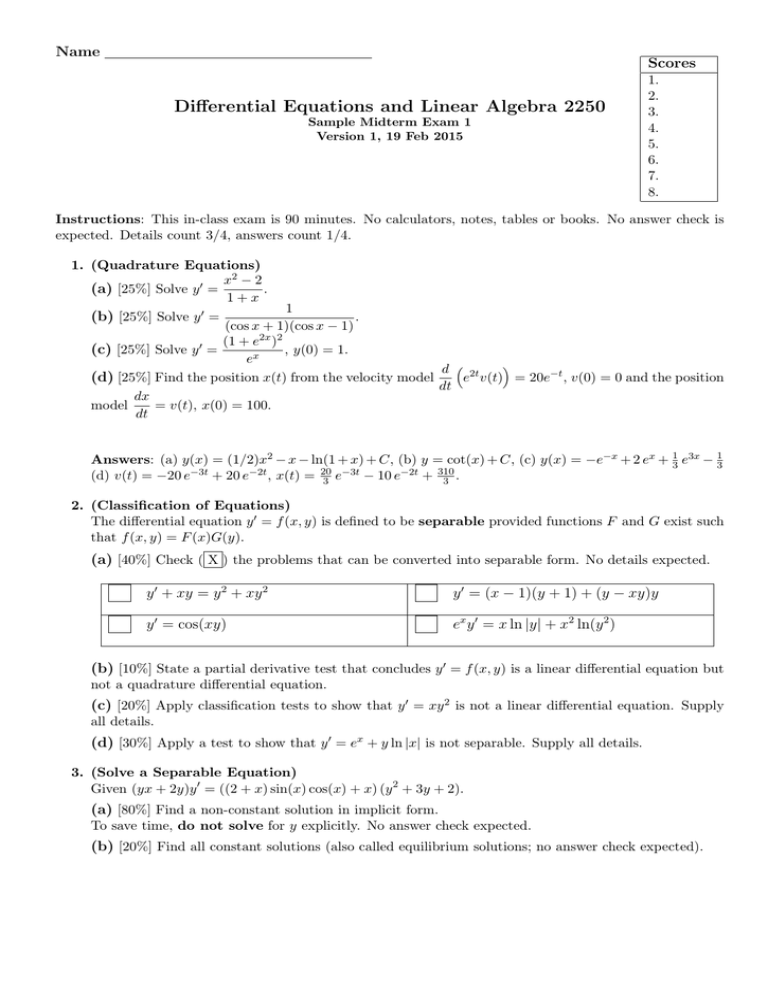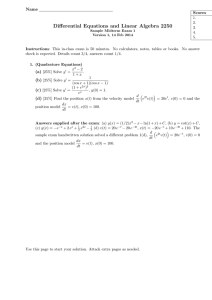Differential Equations and Linear Algebra 2250 Name Scores
advertisement

Name Scores Differential Equations and Linear Algebra 2250 Sample Midterm Exam 1 Version 1, 19 Feb 2015 1. 2. 3. 4. 5. 6. 7. 8. Instructions: This in-class exam is 90 minutes. No calculators, notes, tables or books. No answer check is expected. Details count 3/4, answers count 1/4. 1. (Quadrature Equations) x2 − 2 (a) [25%] Solve y 0 = . 1+x 1 (b) [25%] Solve y 0 = . (cos x + 1)(cos x − 1) (1 + e2x )2 (c) [25%] Solve y 0 = , y(0) = 1. ex d 2t e v(t) = 20e−t , v(0) = 0 and the position (d) [25%] Find the position x(t) from the velocity model dt dx model = v(t), x(0) = 100. dt Answers: (a) y(x) = (1/2)x2 − x − ln(1 + x) + C, (b) y = cot(x) + C, (c) y(x) = −e−x + 2 ex + 31 e3x − 13 −3t − 10 e−2t + 310 . (d) v(t) = −20 e−3t + 20 e−2t , x(t) = 20 3 e 3 2. (Classification of Equations) The differential equation y 0 = f (x, y) is defined to be separable provided functions F and G exist such that f (x, y) = F (x)G(y). (a) [40%] Check ( X ) the problems that can be converted into separable form. No details expected. y 0 + xy = y 2 + xy 2 y 0 = (x − 1)(y + 1) + (y − xy)y y 0 = cos(xy) ex y 0 = x ln |y| + x2 ln(y 2 ) (b) [10%] State a partial derivative test that concludes y 0 = f (x, y) is a linear differential equation but not a quadrature differential equation. (c) [20%] Apply classification tests to show that y 0 = xy 2 is not a linear differential equation. Supply all details. (d) [30%] Apply a test to show that y 0 = ex + y ln |x| is not separable. Supply all details. 3. (Solve a Separable Equation) Given (yx + 2y)y 0 = ((2 + x) sin(x) cos(x) + x) (y 2 + 3y + 2). (a) [80%] Find a non-constant solution in implicit form. To save time, do not solve for y explicitly. No answer check expected. (b) [20%] Find all constant solutions (also called equilibrium solutions; no answer check expected). 4. (Linear Equations) (a) [50%] Solve the linear model 4x0 (t) = −160 + steps. 24 x(t), x(0) = 30. Show all integrating factor 2t + 3 dy − (cos x)y = 0. dx dy (c) [30%] Solve 11 + 33y = 5 using the superposition principle y = yh + yp . Expected are answers dx for yh and yp . (b) [20%] Solve the homogeneous equation Answers reported after the exam: (a) x(t) = 20t + 30, (b) y(x) = c esin(x) , (c) y(x) = 5 33 + c e−3x 5. (Stability) (a) [50%] Draw a phase line diagram for the differential equation dx = ln(1 + x4 ) (2 − |3x − 1|)3 (2 + x)(x2 − 4)(1 − x2 )5 . dt Expected in the phase line diagram are equilibrium points and signs of dx/dt. Answers: Roots −2, −1, −1/3, 0, 1, 2. Signs left to right are: MINUS, MINUS, PLUS, MINUS, MINUS, MINUS, PLUS. (b) [50%] Assume an autonomous equation x0 (t) = f (x(t)). Draw a phase diagram with at least 12 threaded curves, using the phase line diagram given below. Add these labels as appropriate: funnel, spout, node [neither spout nor funnel], stable, unstable. − − + − + + x −8 −4 −2 0 1 6. (The 3 Possibilities with Symbols) Let a, b and c denote constants and consider the system of equations 0 −2b − 4 b+1 −1 − b 0 3 −1 1 0 a 0 a x = y z 0 b2 b b2 − b (a) [40%] Determine a and b such that the system has a unique solution. (b) [30%] Explain why a = 0 and b 6= 0 implies no solution. Ignore any other possible no solution cases. (c) [30%] Explain why a = b = 0 implies infinitely many solutions. Ignore any other possible infinitely many solution cases. 7. (Determinants) Do all parts. (a) [10%] True or False? The value of a determinant is the product of the diagonal elements. (b) [10%] True or False? The determinant of the negative of the n × n identity matrix is −1. (c) [20%] Assume given 3×3 matrices A, B. Suppose A2 B = E2 E1 A and E1 , E2 are elementary matrices representing respectively a swap and a multiply by −5. Assume det(B) = 10. Let C = 2A. Find all possible values of det(C). −1 fails to exist, where C equals the transpose of (d) [30%] Determine all values of x for which (I + C) 2 0 −1 0 1 . the matrix 3x x−1 x x (e) [30%] Let symbols a, b, c denote constants. Apply the adjugate [adjoint] formula for the inverse to find the value of the entry in row 3, column 4 of A−1 , given A below. A= 1 1 a 1 1 0 b c 0 0 0 1 0 0 1 2 8. (Vector Spaces) Do all parts. Details not required for (a)-(d). 3 1 1 3 (a) [10%] True or false: There is a subspace S of R containing none of the vectors 1 , −1 , 1 . 2 0 1 3 ~ (b) [10%] True or false: The set of solutions ~u in R of a consistent matrix equation A~u = b can equal all vectors in the xy-plane, that is, all vectors of the form ~u = (x, y, 0). (c) [10%] True or false: Relations x2 + y 2 = 0, y + z = 0 define a subspace in R3 . (d) [10%] True or false: Equations x = y, z = 2y define a subspace in R3 . (e) [20%] Linear algebraR theorems are able to conclude that the set S of all polynomials f (x) = c0 +c1 x+ c2 x2 such that f 0 (x) + 01 f (x)xdx = 0 is a vector space of functions. Explain why V = span(1, x, x2 ) is a vector space, then fully state a linear algebra theorem required to show S is a subspace of V . To save time, do not write any subspace proof details. (f) [40%] Find a basis of vectors for the subspace of R5 given by the system of restriction equations 3x1 2x1 −2x1 2x1 + 2x3 + 4x4 + 10x5 + x3 + 2x4 + 4x5 + 4x5 + 2x3 + 4x4 + 12x5 = = = = 0, 0, 0, 0.







